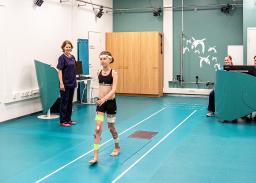Motion Laboratory, New Children's Hospital
Keywords:In the Motion Laboratory, we perform gait analyses utilizing state of the art 3D movement analysis. We are also able to analyze and assess muscle activity, strength and range of motion, balance issues, and foot function.

Analysis of gait problems can be performed for children over the age of 5 who are able to move either independently or with the help of assistive devices.
Our Motion Laboratory is unique as it is the only unit in Finland performing clinical 3D gait analysis. We serve around 100 patients every year. Approximately 85% of the patients analyzed in the Motion Laboratory have cerebral palsy. Other diagnoses of our patients include meningomyelocele, polyneuropathy, spastic paraplegia, idiopathic toe walking, clumsiness, scoliosis, or some other neuro-orthopedic diagnosis.
Analysis in the Motion Laboratory requires a physician’s referral.
The Motion Laboratory performs 3D gait analyses which are then used in the treatment planning and follow-up monitoring of patients with neuro-orthopedic diagnoses. The 3D gait analysis assesses extrinsic forces affecting the body, range of motion in joints, and muscle function during walking. In addition, by obtaining detailed and objective information from gait analysis, we are able to plan surgical treatment and the choice of orthoses in more detail.
Gait analysis benefits children with gait problems who either move independently or with the help of assistive devices. Through gait analysis, we are able to objectively measure movement paths and muscle function while walking, and we are able, for example, to predict the effectiveness of orthopedic surgeries and suitability of any orthoses. While performing gait analysis, we run tests that measure muscle strength, spasticity, range of motion in the joints, balance, and foot function.
The gait analysis utilizes a camera system for recording the patient’s walk. The testing with all its preparations takes around 2–3 hours. The patient is barefoot while the gait capture is active and may also use orthoses. Children coming in for gait analysis must be able to walk around six meters continuously either with or without assistive devices.
You can watch a video on how the gait analysis is conducted.
Muscle weakness and spasticity often accompany physical disabilities and may hinder walking. Surface electromyography (EMG) can be utilized to assess muscle activity during walking. In children with physical disabilities, muscle strength development is often weak relative to their growth and should be monitored regularly. Clinical testing can provide more information about the patient’s muscle strength, spasticity, and range of motion in the joints. Additionally, we can use a muscle testing chair to provide numerical information about the patient’s muscle strength.
Balance testing can be conducted to assess balance control while the patient is standing upright. The test is carried out by using a pressure plate to measure body sway in various standing positions. With the test, we can assess what the patient’s starting level for balance control is currently, and what the effect of different treatments (e.g. treatment for spasticity or a rehabilitation intervention) may be for their balance control. The pressure plate is able to precisely measure pressure distribution in the sole. This enables us to assess foot function both while the patient is standing and while they are walking.
After the patient has undergone the test, a computed analysis will be performed and its data combined with the clinical test results. Based on the results, we will create a report, and possibly a recommendation for treatment.
Patient Guide
The Patient Guide answer the most common questions patients may have before, during, and after treatment.

Maisa online portal (opens in new window, links to another website)
You can use our online services by signing in to the Maisa Portal. Guardians can act on behalf of their children under the age of 18.
